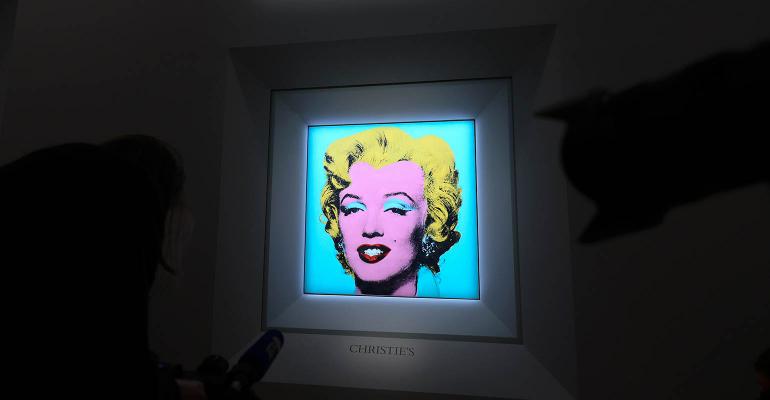(Bloomberg Opinion) -- Technology stocks have taken a deep dive, blue-chip stocks are ailing, stablecoins aren’t stable, and don’t even ask about traditional crypto. Art markets, however, are alive and well — and it’s worth asking why.
Recently an Andy Warhol painting sold at auction for $195 million, the highest price ever for a 20th century artwork. A dance hall-themed painting by Ernie Barnes went for $15.3 million, 76 times the original estimate. The Macklowe collection sold at Sotheby’s for $246.1 million, the most ever for a single collection.
Anyone else notice a pattern? The vigor of the art market may seem counterintuitive, but it makes sense in the current environment.
First, savings are still high due to stinted consumption from the pandemic. And many of the wealthy have been buying additional homes and wish to furnish them with art.
Second, the recent run-up in inflation rates around the world has intensified the search for hedges. There are few true inflation hedges, and crypto now has been knocked out of that role. But art can serve as an inflation hedge in almost any environment.
Art gives its owners the pleasure of looking at it on their wall, and no rate of inflation can take that away. It is both an investment and a form of consumption, and the latter is quite protected against any macroeconomic conditions. When all else fails, spending money is one surefire inflation hedge. Art also happens to be a durable asset, so the expenditure is not entirely wasteful.
Art isn’t always about the enjoyment of the buyer. Many art collectors, especially in the upper tiers of the market, keep their art in tax-free storage and use it to make questionable donations to charity, “flip” it for a fast profit or resell it on the “gray market.” I don’t approve of these methods, but they too can be lucrative in a volatile market where valuations are more subjective.
Many art sellers suggest that artworks bring a high pecuniary rate of return. Don’t be fooled. Too often these calculations are based on “survivorship bias” — that is, the artworks that continue to appear in the auction records are the above-average performers. There is less data on the losers. The best estimates suggest that, over the long run, artworks have less price appreciation than equities.
That is exactly what you would expect if some buyers of art enjoy owning it and looking at it. The net total rates of return, pleasure included, should equalize across different asset classes.
So don’t buy art to get rich. But if you love the work, it will bring more pleasure than holding a lot of losing investments.
The rapid evolution of technology does raise some questions about the future of physical artworks. Why not just have a near-perfect holograph of a Rembrandt on your wall? Why bother trying to buy an original copy of a lesser artwork?
But no one is sure when those quality holographs will arrive — and if they do, they will likely raise rather than lower the value of at least some artworks. The originals will take on greater import, and will be known to a greater number of individuals. The more time we spend looking at computer screens or digital replicas, the greater the value of the very best true art objects (or, for that matter, natural wonders).
To better understand reproducibility and its effects, consider the prints and lithographs of Picasso and Jasper Johns, two especially accomplished printmakers. Those prints and lithographs are excellent in quality and have been available for many decades and are much cheaper than original paintings. Yet if anything they have boosted the reputations of Picasso and Johns, and probably increased the value of their works (both artists sell at or near the top of their market segments). Just as some buyers buy a print because they can’t afford a painting, others start with a print and move into paintings as they earn more.
A warning: The art world is rife with fakes, frauds and uncertainties. So stay away from those market segments that are especially dubious, such as Russian Constructivism. But keep in mind that the downsides of the market end up reflected in price. Precisely because it is not easy for everyone to make wise art purchases, a smart buyer can do especially well.
So before you conclude that all asset classes are collapsing — think again. Beauty should never be too far from your thoughts anyway.
More From Bloomberg Opinion:
- Bitcoin Is a Lot Like the Art Market: Allison Schrager
- NFT Art Is All About the Hype: Leonid Bershidsky
- Rich Millennials Are Splashing Millions on Crypto Art: Andrea Felsted
To contact the author of this story:
Tyler Cowen at [email protected]





